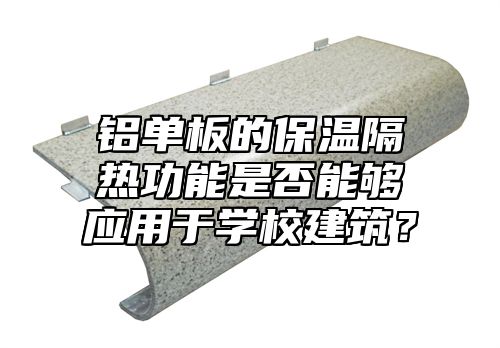

 Industry information
Industry information
Aluminum veneer, as a new type of building material, has attracted much attention for its thermal insulation function. In school buildings, the thermal insulation function of aluminum veneer can play a good role. This article will provide a detailed introduction to the thermal insulation function of aluminum veneer in school buildings from both practical applications and performance advantages.
1、 Practical application
In practical applications, the thermal insulation function of aluminum veneer can play a good role in school buildings. The thermal insulation function of aluminum veneer can effectively reduce the temperature changes on the exterior walls of school buildings, avoiding problems such as excessive air conditioning load caused by temperature changes, thereby reducing the energy consumption of buildings, improving energy utilization efficiency, and ultimately enhancing the overall sustainability of school buildings. The thermal insulation function of aluminum veneer can also reduce the temperature changes on the exterior walls of school buildings, avoiding problems such as thermal expansion and contraction caused by temperature changes, thereby ensuring the structural stability of school buildings. In the production process of aluminum veneer, a series of environmental protection measures are also adopted, such as recycling waste materials, further reducing the degree of environmental pollution and improving the overall sustainability of school buildings.
2、 Performance advantages
In addition to practical applications, the thermal insulation function of aluminum veneer also has performance advantages. With the continuous improvement of people's requirements for school safety and stability, more and more designers are beginning to integrate insulation and thermal insulation functions into school building design schemes. For example, by using aluminum veneer as the exterior wall material in architectural design, different ventilation structures can be selected according to different school uses, such as windows, ventilation openings, etc., in order to achieve better ventilation effects and improve the overall structural stability of school buildings. Aluminum veneer can also be combined with other building materials, such as glass curtain walls, stone curtain walls, etc., to form a more diverse and colorful architectural form, further improving the overall sustainability of school buildings.
3、 Conclusion
Based on the above analysis, it can be seen that the thermal insulation function of aluminum veneer can indeed play a good role in school buildings. Aluminum veneer can effectively improve the overall sustainability and structural stability of school buildings by maintaining a smooth exterior wall surface and reducing environmental impact, among other factors. Aluminum veneer can also bring opportunities for performance advantages, providing architects with more design space and possibilities. The thermal insulation function of aluminum veneer is a very practical and effective technical means, which is worthy of wide promotion and application.